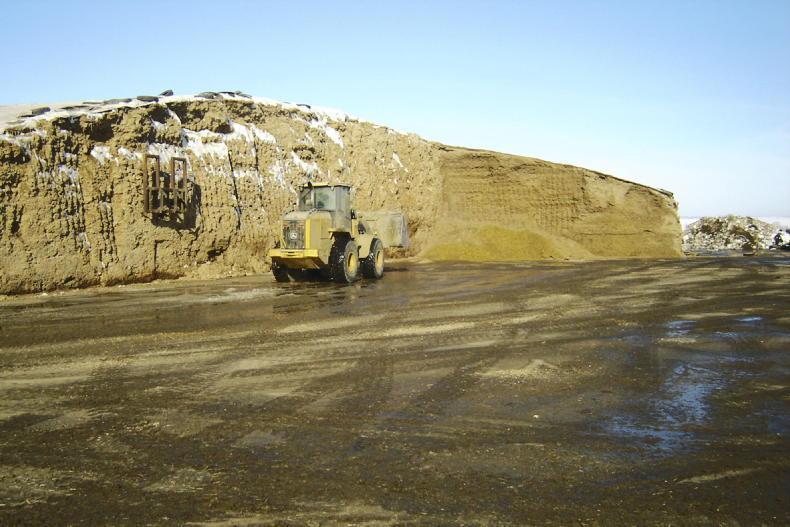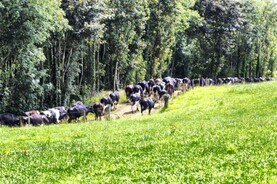A new battle for milk is about to commence in the United States as dairy co-ops and processors open $7bn (€6.4bn) worth of new dairy processing capacity. The new investment, which is primarily in cheese making and whey processing is set to come on stream over the next 18 months. However, according to the National Milk Producers Federation (NMPF) farmers will be under pressure to supply enough milk to keep existing and new plants running.
A new battle for milk is about to commence in the United States as dairy co-ops and processors open $7bn (€6.4bn) worth of new dairy processing capacity. The new investment, which is primarily in cheese making and whey processing is set to come on stream over the next 18 months.
However, according to the National Milk Producers Federation (NMPF) farmers will be under pressure to supply enough milk to keep existing and new plants running.
Milk supply in the United States has flatlined over the last 12 months due to low margins and poor weather conditions resulting in tight feed supplies giving farmers little incentive to expand.
Up to August this year, milk supplies in the US are back 0.8% compared to the same period last year.
There was a high rate of herd dispersals in 2023, with both beef and dairy farmers deciding to reduce or get out of cows. Beef prices have seen historical highs over the last few years and this has fuelled culling rates, particularly in beef herds in more marginal states where both water and feed are scarce.
That beef price has ratcheted up a notch further, with prices for dropped Angus calves from dairy cows now worth north of $1,000 (€925) /head .
These phenomenal prices are due to an increased demand from calf rearers and feedlots, who have contracts to fill and not enough prime cattle to fill them.
Large Holstein cows being crossed with improved dairy beef genetics and the use of growth hormones are obviously making dairy-beef profitable in the US
As a result of the high calf prices, US dairy farmers are breeding more and more cows to beef, with the NMPF saying that over 75% of dairy cows are now being served to Angus sires.
These actions are not without consequences and a shortage of dairy replacements is in turn impacting on farmers’ ability to expand. Freshly calved cows are making between $3,500 to $4,000 (€3,215 to €3,675) a head, double the normal cost.
Avian flu
The NMPF say that lower grain prices and higher milk prices in 2024 mean that producing milk will be quite profitable this year, but for the reasons mentioned above, farmers are unable to turn on the tap of milk and ramp up production.
One area that may be having an impact is animal health, specifically the spread of H5N1 avian influenza. Official figures from the US Department of Agriculture (USDA) put the outbreak at 305 cases in dairy herds since the disease was first observed in dairy cows in March of this year.
However, those on the ground say that the actual outbreak is far greater in size and countless more herds are infected with the disease. The disease is a form of coronavirus which jumped species from wild birds to cows and spreads through milk.
Infected cows are sick with a fever. Those that recover from the fever continue to produce less milk, with many farmers reporting a 30% reduction in yield months after the cows were first infected. The USDA is said to be working on a vaccine, but there are concerns that a vaccine could impact US dairy exports.
Speaking to the Irish Farmers Journal in Washington DC last week, CEO of NMPF Gregg Doud said that the increase in processing capacity is going to drive demand for more milk among processors.
He said that the new cheese and whey plants are ultra-efficient with lower running costs so they can afford to pay more for milk, putting pressure on older, less efficient plants.
NMPF economist Stephen Cain said that a capacity gap between what plants can process and what farmers can supply is expected, but predicts that the gap won’t be as large as some people predict.
He said that most of the cheese plants will also have the capacity to produce high-value whey protein concentrates, similar to the Glanbia plc dairy processing plants. Stephen said the majority of the whey is destined for the export market.
Exports are a key focus for the US dairy sector, with some predictions that US dairy exports are going to grow by 5% per year over the coming years.
Currently, around 15% of the 99bn litres produced annually in the states is exported but with European dairy output set to decline and New Zealand at capacity, the US are set to grow as soon as the short-term supply issues are overcome.
Despite the apparent opportunities in the sector, dairy farmer numbers continue to decline. At the last USDA census in 2022 there was a total of 24,470 dairy farmers in the states, down 39% from 40,336 in 2017.
As some farmers quit, other farmers expand and most of the expansion is coming in the form of large family-owned corporate structures with many thousands of cows per unit.
Doud rejected the notion that water was going to become a limiting factor to dairy farming in places like Texas and New Mexico.
“When we speak to farmers who have established farms in Texas and other areas that are being affected by the receding Ogallala Aquifer, they say that water wasn’t the main factor that brought them there, it was the railroads.
This means they can bring in feed from anywhere in the country, including by-products at relatively low cost so it’s not as much of an issue as some people think,” he says.
Having said that, many of the new large-scale dairy farms are being built in places like South Dakota, where Doud says environmental and water permits are easier to attain.
He also says that some states like South Dakota are more open to the economic activity brought about by dairying than others.

US dairy farming is set to expand in places like South Dakota where feed and water is plentiful.
An example of a state hostile to farming, or at least animal agriculture is California, which in 2018 voted in Proposition 12, which is a rule which prohibits the sale of pork, veal, and egg products in California unless they are produced in compliance with the state’s arbitrary housing requirements.
This not only sets a higher standard for producers in California, as producers nationwide must adhere to the same standards if they are to be permitted to sell their produce in California.
Last May, the US Supreme Court ruled that it was up to congress and not the judiciary to decide on trade rules between states.
This November, voters in Sonoma County California will get to decide on Measure J, a proposal to ban large-scale farms from the county. If approved, around 24 of the largest farms in the county will have to close, mostly dairy and poultry farms.
According to Daniel Munch of the US Farm Bureau, the issues in California are sparked by well-organised and highly funded animal rights groups. Prop 12 has sparked a nationwide debate over the rights of states to set their own laws and the rights of states to trade freely with each other.
The difference between Europe and the United States is particularly stark when it comes to environmental policy.
While the US dairy sector has a target to be greenhouse gas net zero by 2050, it doesn’t have a roadmap or metrics for how to get there.
“Europe uses sticks and mandates to get their farmers to comply but the US doesn’t believe in that. We use initiatives and set targets and the producer then figures out how to get there,” Doud says.
He explains that sustainability is all about economics and any changes must be looked at from a profitability point of view first saying he thinks the European approach to reducing greenhouse gas emissions is “backwards” but that European companies such as Danone and Nestlé operating in the US are putting pressure on US agriculture to reduce emissions.
On who will pay for environmental compliance, he doesn’t believe that the consumer will pay but that the customer [food company] will have to pay for it.
In short
There is renewed investment in the US dairy sector with co-ops and private companies investing $7bn in stainless steel over the next 18 months. Dairy farmers are having a good year in 2024 but expansion has flatlined as heifers are scarce and cull cow and dairy calf prices are historically high. Bird flu is likely to have some impact on the milk supply and the USDA is investigating vaccine options. US milk producers have a target of net zero greenhouse gas emissions by 2050 but no real roadmap about how to get there. 




SHARING OPTIONS: